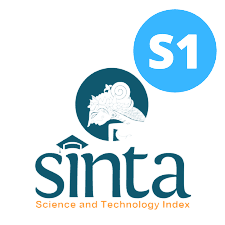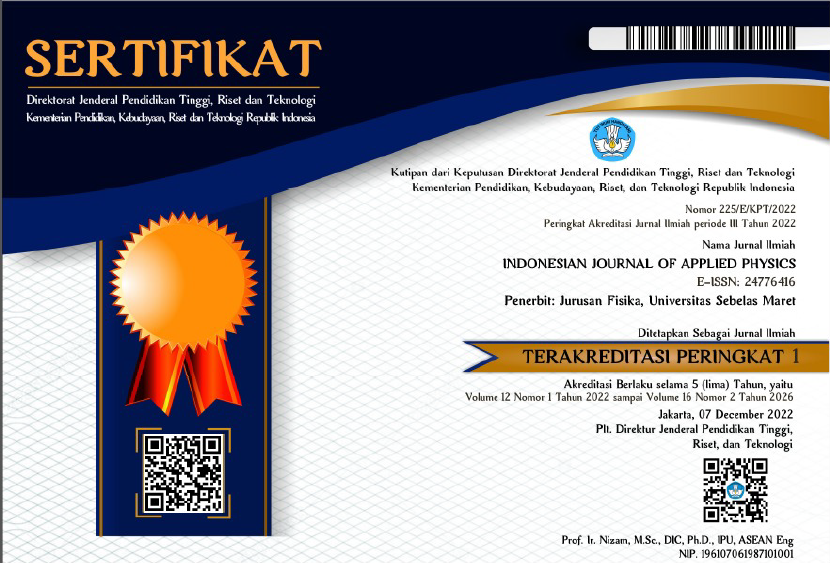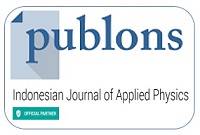Assessment of Settlement Area Development in Jember Regency Area Based on Multitemporal LANDSAT 8 OLI-TIRS Data
Abstract
Keywords
Full Text:
PDFReferences
1 BPS. 2014. Jember Dalam Angka 2014. Jember
2 BPS. 2023. Jember Dalam Angka 2023. Jember
3 Farizki, M., & Anurogo, W. 2017. Pemetaan kualitas permukiman dengan menggunakan penginderaan jauh dan SIG di kecamatan Batam kota, Batam. Majalah Geografi Indonesia, 31(1), 39-45.
4 Widodo, S., & Pristianto, H. 2021. Prediksi Penggunaan Lahan Kota Sorong Menggunakan Citra Landsat Multi Waktu Dengan Metode CA-Markov. Jurnal Teknik Sipil: Rancang Bangun, 7(2), 62–70.
5 Cahyono, B. E., Febriawan, E. B., & Nugroho, A. T. 2019. Analisis Tutupan Lahan Menggunakan Metode Klasifikasi Tidak Terbimbing Citra Landsat di Sawahlunto, Sumatera Barat. Teknotan: Jurnal Industri Teknologi Pertanian, 13(1), 8-14.
6 Bashit, N., Prasetyo, Y., & Sukmono, A. 2019. Kajian Perkembangan Lahan Terbangun Kota Pekalongan Menggunakan Metode Urban Index (Ui). Elipsoida : Jurnal Geodesi Dan Geomatika, 2(2), 12–18.
7 Andiko, J. A., Duryat, & Darmawan, A. 2019. The Efficiency of Multisensor Images for Land Cover Mapping. Jurnal Sylva Lestari, 7(3), 342-349.
8 Hadi, B. S. 2019. Penginderaan Jauh: Pengantar ke Arah Pembelajaran Berpikir Spasial. Yogyakarta: UNY Press.
9 Wulder, M. A., Loveland, T. R., Roy, D. P., Crawford, C. J., Masek, J. G., Woodcock, C. E., . . . Zhu, Z. 2019. Current status of Landsat program, science, and applications. Remote Sensing of Environment, 225, 127-147.
10 Nurhayati, S., Rahman, A., & Dharmaji, D. 2020. Aplikasi Data Citra Satelit Landsat 8 OLI-TIRS dan Sistem Informasi Geografis Untuk Mengetahui Sebaran Kualitas Air di Waduk Riam Kanan Kecamatan Aranio, Kabupaten Banjar, Provinsi Kalimantan Selatan. AQUATIC Jurnal Manajemen Sumberdaya Perairan, 3(2), 81–99.
11 Al-Zuhairi, M., Nahas, F., Hussein, F., Pradhan, B., & Shariff, R. 2016. A refined classification approach by integrating Landsat Operational Land Imager (OLI) and RADARSAT-2 imagery for land-use and land-cover mapping in a tropical area. International Journal of Remote Sensing, 37, 2358-2375.
12 Barbosa, F. L. R., Guimarães, R. F., Junior, O. A. d. C., & Gomes, R. A. T. 2021. Land Use/Land Cover (LULC) classification based on SAR/Sentinel 1 image in Distrito Federal, Brazil. Sociedade & Natureza, 33, e55954.
13 Pareeth, S., Karimi, P., Shafiei, M., & De Fraiture, C. 2019. Mapping Agricultural Landuse Patterns from Time Series of Landsat 8 Using Random Forest Based Hierarchial Approach. Remote Sensing, 11(5).
14 Tan, K. C., Lim, H. S., MatJafri, M. Z., & Abdullah, K. 2010. Landsat data to evaluate urban expansion and determine land use/land cover changes in Penang Island, Malaysia. Environmental Earth Sciences, 60(7), 1509-1521.
15 Nengsih, W. 2019. Analisa Akurasi Permodelan Supervised dan Unsupervised Learning Menggunakan Data Mining. Sebatik, 23(2), 285–291.
16 Jin, Z., Shang, J., Zhu, Q., Ling, C., Xie, W., & Qiang, B. 2020. RFRSF: Employee Turnover Prediction Based on Random Forests and Survival Analysis. Online: Information Systems Engineering – WISE 2020, Chma.
17 Breiman, L. 2001. Random Forests. Machine Learning, 45(1), 5-32.
18 Adrian, M. R., Putra, M. P., Rafialdy, M. H., & Rakhmawati, N. A. 2021. Perbandingan Metode Klasifikasi Random Forest dan SVM Pada Analisis Sentimen PSBB. Jurnal Informatika Upgris, 7(1), 6–11.
19 Primajaya, A., & Sari, B. N. 2018. Random Forest Algorithm for Prediction of Precipitation. Indonesian Journal of Artificial Intelligence and Data Mining, 1(1), 27-31.
20 Papilaya, P. P. E. 2022. Aplikasi Google Earth Engine Dalam Menyediakan Citra Satelit Sumberbedaya Alam Bebas Awan. MAKILA, 16(2), 96-103.
21 Fikri, A. A., Darmawan, A., Hilmanto, R., Banuwa, I. S., Agustiono, A., & Agustiana, L. (2022). Pemanfaatan platform Google Earth Engine dalam Pemantauan Perubahan Tutupan Lahan di Taman Hutan Raya Wan Abdul Rachman. Journal of Forest Science Avicennia, 5(1), 46–57.
22 Lidiawati, I., Hasibuan, R. S., & Wijayanti, R. (2019). Perubahan Penutupan Lahan Kota Bogor. Talenta Conference Series: Agricultural and Natural Resources (ANR), 2(1), 44-51.
Refbacks
- There are currently no refbacks.
















